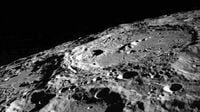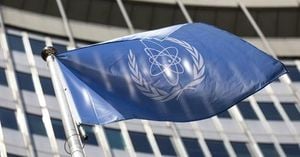It’s a headline that would have seemed straight out of a sci-fi novel just a few years ago: the United States and China are racing to build nuclear reactors on the Moon. Yet, in August 2025, the acting NASA Administrator Sean Duffy announced that the agency aims to have a 100-kilowatt nuclear microreactor operational on the Moon by 2030. This bold plan, echoing China’s own declaration in April to establish a lunar nuclear power plant by 2035, is set to transform not only the future of space exploration but also the geopolitical landscape beyond Earth.
According to Engadget, NASA’s ambitions aren’t entirely new. The agency, alongside the Department of Energy, has been quietly funding research into space-based fission power for more than sixty years. “We’ve done this for more than 60 years,” Professor Bhavya Lal, a former acting chief technologist at NASA, explained. The first U.S. nuclear reactor in space, SNAP-10A, launched all the way back in 1965. Since then, both the U.S. and the former Soviet Union have relied on radioisotope generators—small nuclear power sources—to keep satellites, Mars rovers, and deep-space probes running when solar power just wouldn’t cut it.
But why nuclear, and why now? The answer, as Lal and other experts point out, is in the numbers. “You can get massive amounts of power from very little mass,” says Nick Touran, a reactor physicist and founder of What is Nuclear. On the Moon, where nights last a grueling 14 Earth days and some craters never see sunlight, solar panels simply can’t provide reliable, round-the-clock energy. “If you’re going to do any kind of commercial activity on the Moon, we need more than solar can provide,” Lal emphasized. Even basic 3D printing or life-support systems for lunar habitats would require hundreds of kilowatts—far more than solar arrays and batteries could realistically supply without constant resupply from Earth.
Michelle L.D. Hanlon, a professor of air and space law at the University of Mississippi, describes the current moment as an “infrastructure race.” In her view, infrastructure is influence—and on the Moon, that influence could be decisive. “A lunar nuclear reactor may sound dramatic, but it’s neither illegal nor unprecedented,” Hanlon wrote in The Conversation. International law, including the 1967 Outer Space Treaty, permits the peaceful use of nuclear power on the Moon, provided countries act with “due regard to the corresponding interests of all other States Parties.” In practice, this means that whoever builds the first reactor could shape the norms, legal interpretations, and practical boundaries of lunar activity for years to come.
Indeed, the 1992 United Nations Principles Relevant to the Use of Nuclear Power Sources in Outer Space lay out guidelines for safety, transparency, and international consultation. While these principles are nonbinding, they represent a global consensus that nuclear energy may be essential for missions where solar power falls short. The Outer Space Treaty itself prohibits territorial claims but allows countries to establish installations—like bases or power plants—that can, in effect, control access to their immediate surroundings. “Building infrastructure is not staking a territorial claim,” Hanlon noted, “but one country setting up a reactor could shape where and how others operate—functionally, if not legally.”
The stakes are especially high at the lunar south pole, a region coveted for its permanently shadowed craters filled with ice. That ice could be transformed into rocket fuel or drinking water, making it a crucial resource for any long-term lunar base. As multiple countries eye these scientifically and geopolitically sensitive zones, the first to establish a reactor and supporting infrastructure could gain a significant advantage—not just in science, but in shaping who gets to use the Moon’s most valuable real estate.
Of course, building a nuclear reactor on the Moon is no small feat. NASA’s planned 100-kilowatt microreactor would weigh between 10 and 15 metric tons—more than any current commercial rocket can lift. The reactor’s radiator alone, once unfolded, would be about the size of a basketball court. The agency is banking on SpaceX’s Starship, a super heavy-lift rocket, to be ready by 2030. But as Engadget reports, 2025 has been a rough year for Starship, with two out of three test flights ending in explosions. Without a reliable way to deliver such a massive payload, the timeline for NASA’s lunar reactor could slip.
There’s also the challenge of building the reactor itself. While several companies are developing microreactors, none are yet in the prototype stage. “It takes a few iterations to get a reactor up to a level where it’s operable, reliable and cost effective,” Touran says. Still, he remains optimistic: “I think we’re in a great spot to take a good swing at this by 2030.” NASA and the Department of Energy’s 2018 demo of the KRUSTY fission system—a lightweight, 10-kilowatt reactor—proved that new designs can work, even on a modest budget.
Yet, perhaps the most significant hurdle is organizational. NASA is facing a workforce reduction of about 4,000 employees by the end of July 2025, a move prompted by broader federal government cuts. That’s roughly a fifth of the agency’s staff, and morale is reportedly at an all-time low. “The contradiction inherent in this proposal is that the White House is directing NASA to do the two most ambitious and difficult projects any space program can do…but to do so with a resource level and workforce equivalent to what the agency had before the first humans went to space in 1961,” said Casey Dreier of The Planetary Society. The reductions come at a time when the agency needs every bit of expertise it can muster, particularly in nuclear engineering—a field where talent is already scarce.
Still, NASA remains officially upbeat. In a statement shared with Engadget, Secretary Duffy downplayed concerns about staffing: “NASA remains committed to our mission, even as we work within a more prioritized budget and changes with our workforce. NASA retains a strong bench of talent. I am confident that our exceptional team remains capable of executing upon my directives safely and in a timely manner and will continue to carry our work forward.”
The financial commitment is substantial: Lal and her co-author, Dr. Roger Myers, estimate it will cost about $800 million a year for five years to build and deploy the lunar reactor. And even with support from the Department of Energy and private industry, the project’s success will hinge on both technical breakthroughs and sustained political will.
While critics worry about the environmental and operational hazards of nuclear reactors in space, Hanlon points out that strict adherence to U.N. safety protocols could mitigate those risks. And in the grand scheme, the ability to power habitats, mining operations, and research stations continuously—on the Moon and, eventually, Mars—could be the linchpin for humankind’s next great leap.
As the U.S. and China accelerate their plans, the race is no longer just about flags and footprints. It’s about who will build the infrastructure that defines the next era of space exploration—and, by extension, who will shape the future rules of the final frontier.





